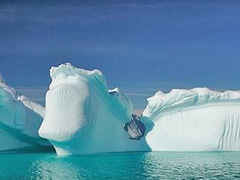
The sea fauna has suffered somewhat as well. The Southern Ocean temperatures have risen by more than 1.5 degrees F over a period of 50 years, which has affected Antarctic sea urchins more than any other species. The temperature increase has forced them to search for better living conditions elsewhere. Among other ocean species affected by the Antarctica global warming facts are the Krill, which are shrimp-like crustaceans who require polar ice caps in order to reproduce. The temperature rise decreases the size of the ice cap and takes away the shelter available for the continuation of the species. Krill are important to the fauna, because they serve as a food source for various Antarctic mammals and birds, such as seals, penguins, and whales. As the reduction in the krill population continues, other animals up the food chain are affected and become subject to starvation.
Another species that seem to be in danger in the Antarctic region is the limpets, which are a type of snail in the region. What happens when the temperature of the water increases is that when they are flipped over, limpets are no longer able to turn themselves back up. It’s important to point out that skill is crucial in order for them to survive in an environment where icebergs prevail.
For more information on global warming, go to:
http://en.wikipedia.org/wiki/Global_warming
http://www.epa.gov/climatechange/
Related Posts
- Impact of Global Warming on Earth – updated article
- Impact of Global Warming on Earth
- Invasion of the Mangroves
- Top 5 Causes and Effects of Global Warming - Updated Article With Extra Information
- New York City Continues Environment Focus with New Panel on Climate Change
Leave a Reply
You must be logged in to post a comment.




